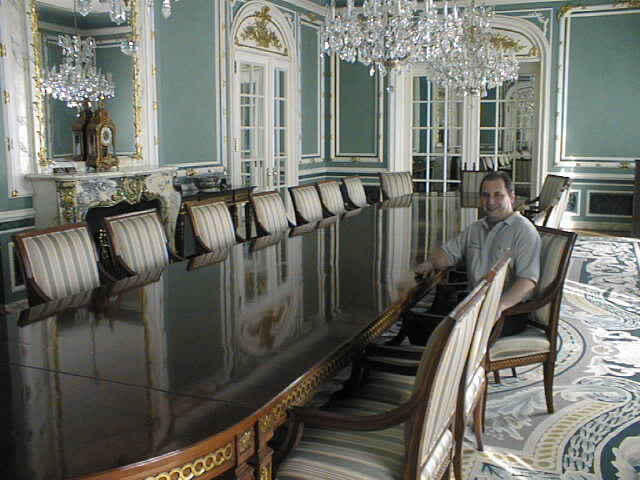Spring Home & Garden
Reviving Old Furniture
The old antique desk with the broken drawer has been sitting in your attic for years, waiting for the day when you finally drag it out to have it restored and made presentable again. But wait. Do you restore it? Or do you refinish it? Or does it really matter? Well, it does matter. Because whatever you do to improve the appearance of that old desk may very well end up impacting its value and not always for the better.
First of all, is the piece really an antique? For insurance purposes, antiques are defined as pieces that are at least 100 years old. Anything less than that is just "old" (still valuable maybe, but not yet classified as an antique). Secondly, restoring and refinishing antiques are two different processes. According to Larry Manoly, owner of Manoly Furniture Service, restoring an antique means taking it back to its original condition and finish.
Restoration
"You're trying to take the piece back to the way it was when the piece was designed, and when it was built," he said. When you're restoring, you have to create the original finishes. You really don't want to strip off any old finishes, dents, gouges, scratches, marks—you don't want to take those out. You want to use the same type of hardware. You want everything to be original. And you want to get it to look as good as it can.
Manoly says restoring is a time consuming and sometimes an expensive process, but worth it for preserving the value of expensive antiques. For instance, he has restored an oak china cupboard that has been appraised at $20,000. If during the restoration, the old glass, which had begun to "bubble" from age, had been replaced with new glass, the value of the piece would have dropped. Someone who did not know what they were doing could easily have made that mistake. Whatever your piece is worth the cost of the restoration is really up to you, said Manoly. "A lot of times," he said, "people will put a lot more money into having a piece restored than the piece is actually worth. But when you're dealing with the average consumer, where it's a family heirloom or something that they just really love—it was their mother or father's, maybe a little writing desk from when they grew up—then money is not the issue. It's having the memory that's the issue." If you got a little antique rocking chair that maybe is worth $100.00, but maybe needed to be re-caned and refinished and re-done and it's going to cost $300.00, is it worth it to you to do that? To you, it might be."
The process of restoring a piece of furniture, like the oak piece mentioned earlier, is involved. The first thing Manoly does is photograph the furniture so that the finished piece is put back together in its original form. Then the piece is broken down as much as possible. "We take it apart as far as it's able to go," Manoly said. We don't break the joints apart, but if the doors can come off, we break the piece down that way." Next, the old finished is removed, but not by the old process of dipping that once was widely used in the furniture business. The old dipping process involved a lye stripper, which was extremely hard on the wood. "Nobody dips anymore," said Manoly. “It would just tear the heck out of the furniture." Once the furniture is stripped, Manoly and his staff will make any necessary repairs that are needed, then sand it to get it back to its original look. Chemicals are applied to remove some of the harsh effects of the stripper and ensure that the stain will go on naturally. "If you see some pieces that people have done on their own,” Manoly said, when they stain it, it’s real dark in some places, in some real light. It looks blotchy." The cause, he said, is poor preparation. Finally, finishes and stains are applied, a topcoat is added and the whole process is "rubbed out" or buffed to make it shine. Any hardware for the piece is also cleaned and installed. The furniture is now ready to be delivered back to its owner.
Refinishing
Refinishing, on the other hand, is a less costly process because it only involves "refurbishing" or making a piece look as close as possible to the original, but without worrying about using authentic finishes and hardware. "Refinishing is always cheaper than if you had to replace a piece," said Manoly. But refinishing, unlike restoration, usually involves stripping a piece back to the original wood before applying new stains, which does not diminish its value. "If you're concerned about value," said Manoly, "you don't want to strip off the old finish and go down to the bare wood. But, sometimes a piece has been so badly deteriorated that you have no choice but to refinish the piece. It's not even a question of trying to restore it back. So, you have the burden of saying yes, this may lose some of its value by refinishing it. But, at the same time, it will look a thousand times better. And if, as Manoly said, it's a piece of furniture you want to hand down to your child mostly for sentimental reasons, that may be all that is necessary.
As Manoly talks about his craft, his expertise-honored by many years of hard work - is obvious. "Experience is really the best teacher," said Manoly. He should know, having worked since high school in a family business that was built on his grandfather's know-how and fostered by two generations of son's knowledge and trust.
Manoly’s furniture maintains a website that includes a photo gallery of some of his restorations. You can get more info on Manoly Furniture Service by visiting his website at www.manoly.com.

